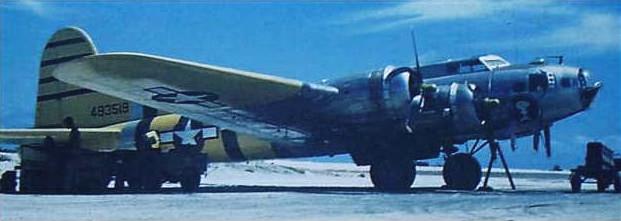Boeing QB-17 (Q-7)
After the end of World War II, a large number of B-17G Flying Fortress bombers became surplus to USAAF (and later USAF) requirements. Some of these were converted to unmanned QB-17 configuration, mostly for use as aerial targets. The first conversions, known as QB-17G, were made in 1946 for air sampling near or within the mushroom clouds of the "Operation Crossroads" nuclear tests. However, most QB-17s were QB-17L or QB-17N target drones, which were used during the 1950s in tests of guided missiles. The QB-17L had television cameras and transmitters to provide a direct view of the incoming missile. The QB-17N had a different remote-control system and no on-board TV equipment. Instead, it could be fitted with tracking equipment in wingtip pods, which were parachute-recoverable even when the drone was destroyed. The last flying QB-17 was destroyed in a missile test in 1960.
 |
| Photo: USAAF |
| QB-17G |
In December 1953, the Wright Air Development Center (WADC) had requested to replace the designation QB-17 by Q-7A, Q-7B and Q-7C. Although only the QB-17G designation was explicitly mentioned once in the request (mostly the drone was simply referred to as QB-17), the request's subject were obviously three different drone configurations. It's not unlikely that these were the QB-17G, -17L and -17N. WADC argued that the existing QB-17 nomenclature led to unnecessary problems and delays in the production and support of the drones, because they were too easily confused with unmodified B-17 aircraft. However, the ARDC (Air Research & Development Command) did not concur with this reasoning, and turned the request down in March 1954. Because the Q-7 designation was not re-used otherwise, the #7 slot in the Q-series remained unassigned (see also Q-8).
Specifications
Note: Data given by several sources show slight variations. Figures given below may therefore be inaccurate!
Data for QB-17L (based on B-17G data):
| Length | 22.66 m (74 ft 4 in) |
| Wingspan | 31.62 m (103 ft 9 in) |
| Height | 5.84 m (19 ft 2 in) |
| Weight | Empty: 16300 kg (36000 lb) |
| Speed | 462 km/h (287 mph) at 7600 m (25000 ft) |
| Ceiling | 10850 m (35600 ft) |
| Propulsion | 4x Wright R-1820-97 piston engine; 890 kW (1200 hp) each |
Main Sources
[1] USAF Aircraft Nomenclature Records
[2] Peter M Bowers: "Boeing Aircraft since 1916", Putnam, 1989
Back to Directory of U.S. Military Rockets and Missiles, Appendix 1
Last Updated: 25 November 2006